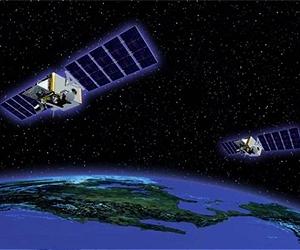TV Screens show Indian Prime Minister Narendra Modi greeting Indian Space Research Organisation (ISRO) scientists and other officials after the success of Mars Orbiter Mission at their Telemetry, Tracking and Command Network complex in Bangalore, India, Wednesday, Sept. 24, 2014.
India triumphed in its first interplanetary mission, placing a satellite into orbit around Mars on Wednesday morning and catapulting the country into an elite club of deep-space explorers.
Credit: AP Photo/Aijaz Rahi
India triumphed in its first interplanetary mission, placing a satellite into orbit around Mars on Wednesday morning and catapulting the country into an elite club of deep-space explorers.
Scientists broke into wild cheers as the orbiter's engines completed 24 minutes of burn time to maneuver the spacecraft into its designated place around the red planet.
"We have gone beyond the boundaries of human enterprise and innovation," Prime Minister Narendra Modi said, standing alongside scientists with the
Indian Space and Research Organisation (ISRO) at the command center in the southern tech hub of Bangalore.
"We have navigated our craft through a route known to very few," Modi said, congratulating the scientists and "all my fellow Indians on this historic occasion."
Scientists described the final stages of the
Mars Orbiter Mission, affectionately nicknamed
MOM, as flawless.
The success marks a milestone for the space program in demonstrating that it can conduct complex missions and act as a global launch pad for commercial, navigational and research satellites.
It's also a major feat for the developing country of 1.2 billion people, most of whom are poor.
At the same time, India has a robust scientific and technical educational system that has produced millions of software programmers, engineers and doctors, propelling many into the middle class.
Getting a spaceship successfully into orbit around Mars is no easy task. More than half the world's previous attempts, 23 out of 41 missions, have failed, including the
Beagle-2 from the UK and
Nozomi by Japan in 1999.
Indian Space Research Organization scientists and other officials cheer as they celebrate the success of Mars Orbiter Mission at their Telemetry, Tracking and Command Network complex in Bangalore, India, Wednesday, Sept. 24, 2014.
Credit: AP Photo/Aijaz Rahi
The United States had its first success with a 1964 flyby by a spacecraft called
Mariner 4, returning 21 images of the surface of the planet.
The former
Soviet Union MARS-3 reached the planet in 1971, and the
European Space Agency Mars Express in 2003, still operating successfully around Mars.
The U.S. space agency NASA congratulated India in a Twitter message welcoming
MOM to studying the red planet.
On Sunday, NASA achieved its own success in placing its
Mars Atmosphere and Volatile Evolution mission (Maven), in position.
The U.S. has two more satellites circling the planet at the moment, as well as two rovers rolling across the rocky Martian surface.
The ESA's
Mars Express, launched over a decade ago, is still operating as well.
India was particularly proud that
MOM was developed with homegrown technology and for a bargain price of about $75 million, a cost that Modi quipped was lower than many Hollywood film budgets.
By comparison, NASA's much larger
Maven mission cost nearly 10 times as much at $671 million.
The real test of these missions will come when the scientific data is gathered and returned for examination.
In this Sept. 11, 2013, file photo, Indian engineers work on the Mars orbiter spacecraft at the satellite center of Indian Space Research Organization (ISRO) in Bangalore, India.
Credit: AP Photo/Aijaz Rahi, File
Indian scientists "designed the trajectory aspects and the interplanetary aspects," said
Vipparthi Adimurthy of the
Indian Institute of Space Science and Technology, who headed the team that crafted the first feasibility studies on whether India could reach Mars.
"Today not only has a dream come true, but we have created history for India, for
ISRO, and for the world," he said.
The 1,350-kilogram (nearly 3,000-pound) orbiter will now circle the planet for at least six months, with five solar-powered instruments gathering scientific data that may shed light on Martian weather systems as well as what happened to the water that is believed to have existed once on Mars in large quantities.
The 15 kgs payloads on the Mars Orbiter Mission include:
Lyman Alpha Photometer (LAP), an absorption cell photometer that measures relative abundance of deuterium and hydrogen from Lyman-alpha emission in the Martian upper atmosphere.
Methane Sensor for Mars (MSM), designed to measure methane in the Martian atmosphere with PPB accuracy and map its sources.
Mars Exospheric Neutral Composition Analyser (MENCA), a quadruple mass spectrometer capable of analysing the neutral composition in the range of 1 to 300 amu with unit mass resolution.
Mars Colour Camera (MCC), a tri-colour camera that gives images and information about the surface features and composition of Martian surface.
Thermal Infrared Imaging Spectrometer (TIS) to measure the thermal emissions and, because it is not using visible light, this instrument can be operated both during th day and night.
Temperature and emissivity are two basic physical parameters estimated from thermal emission measurement.











































